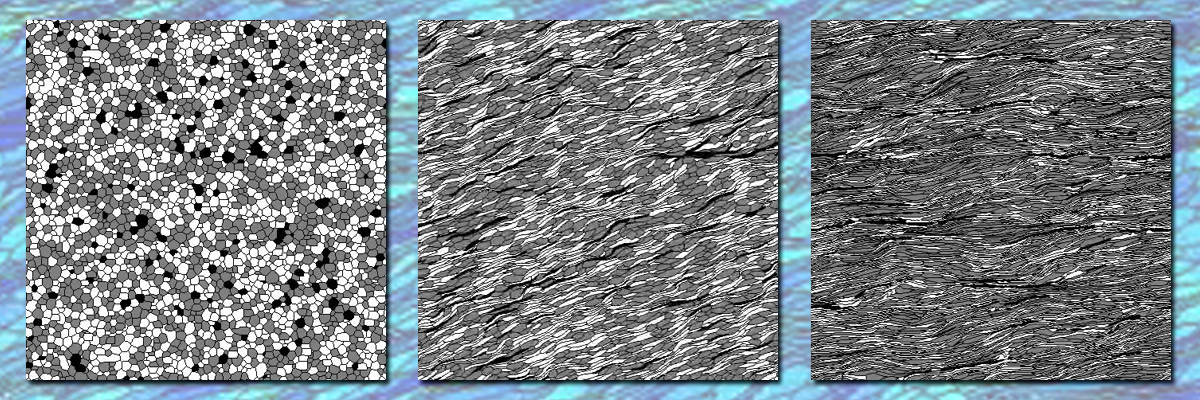2 de November de 2020
C’ shear bands are a common feature in nature and they are widely used as kinematic indicators to study deformation processes of rocks in the deep parts of the Earth’s crust. However, there is little consensus about how they form. Now, using numerical simulations, a new study has been able to determine how shear bands form and develop in rocks composed of more than one mineral. Melanie Finch, researcher at Monash University (Australia), is the first author of a study published in the Journal of Structural Geology. María Gema Llorens, researcher at GEO3BCN-CSIC has participated in this study.
The research team used numerical simulations to investigate the microstructural development during deformation of a “virtual rock”, a squared microstructure sized 10×10 cm, composed of three minerals that approximated the properties of quartz, feldspar and mica. The proportion and relative strength of the minerals was modified then in order to “understand how these two parameters control the location and the formation of shear bands”, says María Gema Llorens.
Researchers found that C’ shear bands develop in models with at least 5% of mica, the weak mineral, when there is a considerable strength contrast between minerals. But they also occur when the mica proportion is higher than 15%. In this case, contrary to what it was previously thought, C’ shear bands can form and develop at low strain rate areas.
The authors of the study were also able to confirm that C’ shear bands are ephemeral microstructures. “They form and deactivate as the deformation evolves. This is why it is important to develop methods to visualize and quantify the whole deformation process”, says Llorens. According to the article, numerical modelling allows insight into developing microstructures at small deformation increments, so it can provide valuable information about processes that have previously only been inferred in studies on experimentally- and naturally deformed rocks, the study says.
By using numerical modelling software of viscoplastic deformation, researchers were able to run numerical simulations of dozens of models. “The code was initially designed to simulate metal deformation, although it is usually also applied to study rocks”, comments Llorens.
Researchers estimated the crystalline properties of the different minerals to create a “virtual rock”. This numerical file defines “a microstructure with grains that are defined by boundary nodes. The models begin with an undeformed rock and the microstructure of the minerals progressively develops step by step under simple shear deformation”, says Llorens.
The simulation software recorded data that allowed researchers to make movies of grains deforming as well as to visualize the strain rate and stress distribution. These movies provide information about shear zone development and also allow the observation of the structures typically seen in natural shear zones.
“This type of numerical simulation allows us to observe and understand the whole formation process. Until now, we weren’t able to trace the complete evolution of such rocks during their deformation, neither how shear bands form and deactivate progressively”, explains Llorens.
The analysis of shear bands is key to determine the direction of the deformation on rocks and, moreover, it allows the analysis of other structures at larger scales. Being a kinematic indicator, it is possible, for example, “to investigate shear zones on a mountain range to know which has been the direction of tectonic plate collision”.
Other participants in the study are researchers from Eberhard Karls University Tübingen, Universitat Autónoma de BArcelona (UAB), Universitat de Barcelona and China University of Geosciences in Beijing. The article has become one of the most downloaded papers from the journal in the last 90 days.
Reference article
Finch, M.A., P.D. Bons, F. Steinbach, A. Griera, M.-G. Llorens, E. Gomez-Rivas, H. Ran, and T. de Riese. “The Ephemeral Development of C′ Shear Bands: A Numerical Modelling Approach.” Journal of Structural Geology 139 (October 2020): 104091. https://doi.org/10.1016/j.jsg.2020.104091.

